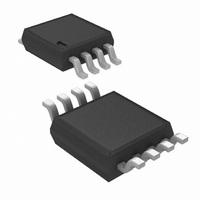LM77CIMMX-3/NOPB National Semiconductor, LM77CIMMX-3/NOPB Datasheet - Page 6

LM77CIMMX-3/NOPB
Manufacturer Part Number
LM77CIMMX-3/NOPB
Description
IC TEMP SENSOR/COMP DGTL 8-MSOP
Manufacturer
National Semiconductor
Datasheet
1.LM77CIMM-3NOPB.pdf
(18 pages)
Specifications of LM77CIMMX-3/NOPB
Function
Temp Monitoring System (Sensor)
Topology
ADC, Comparator, Register Bank
Sensor Type
Internal
Sensing Temperature
-55°C ~ 125°C
Output Type
I²C™
Output Alarm
Yes
Output Fan
No
Voltage - Supply
3 V ~ 5.5 V
Operating Temperature
-55°C ~ 125°C
Mounting Type
Surface Mount
Package / Case
8-MSOP, Micro8™, 8-uMAX, 8-uSOP,
Lead Free Status / RoHS Status
Lead free / RoHS Compliant
Other names
LM77CIMMX-3
Available stocks
Company
Part Number
Manufacturer
Quantity
Price
Part Number:
LM77CIMMX-3/NOPB
Manufacturer:
TI/德州仪器
Quantity:
20 000
www.national.com
Note 13: Hysteresis value adds to the T
subtracts from the T
discussion of the function of hysteresis refer to Section 1.1, TEMPERATURE COMPARISON, and
Note 14: Default values set at power up.
Note 15: Timing specifications are tested at the bus input logic levels (Vin(0)=0.3xVA for a falling edge and Vin(1)=0.7xVA for a rising edge) when the SCL and
SDA edge rates are similar.
1.0 Functional Description
The LM77 temperature sensor incorporates a band-gap type
temperature sensor, 10-bit ADC, and a digital comparator
with user-programmable upper and lower limit values. The
comparator activates either the INT line for temperatures out-
side the T
temperatures which exceed T_CRIT. The lines are pro-
grammable for mode and polarity.
1.1 TEMPERATURE COMPARISON
LM77 provides a window comparison against a lower (T
and upper (T
(T_CRIT) functions as a critical alarm shutdown.
picts the comparison function as well as the modes of oper-
ation.
1.1.1 Status Bits
The internal Status bits operate as follows:
“True”: Temperature above a T
those respective bits. A “true” for T
T
“ False”: Assuming temperature has previously crossed
above T
low the points corresponding T
T_CRIT − T
T
T
T
The Status bits are not affected by reads or any other actions,
and always represent the state of temperature vs. setpoints.
LOW
LOW
LOW
HYST
.
, assuming temperature has previously crossed below
, a “false” occurs when temperature goes above T
.
HIGH
LOW
HYST
or T_CRIT, then the temperature must drop be-
HIGH
and T
HIGH
) in order for the condition to be false. For
) trip point. A second upper trip point
and T_CRIT setpoints (e.g.: if T
FIGURE 2. Temperature-to-Digital Transfer Function (Non-linear scale for clarity)
HIGH
window, or the T_CRIT_A line for
LOW
HIGH
LOW
HYST
setpoint value (e.g.: if T
or T_CRIT is “true” for
is temperature below
(T
HIGH
HIGH
− T
Figure 3
setpoint = 64°C, and hysteresis = 2°C, then actual hysteresis point is 64−2 = 62°C). For a detailed
HYST
LOW
LOW
LOW
de-
setpoint = 10°C, and hysteresis = 2°C, then actual hysteresis point is 10+2 = 12°C); and
or
+
)
6
1.1.2 Hardwire Outputs
The T_CRIT_A hardwire output mirrors the T_CRIT_A flag
unless the part is read. When the flag is true, the T_CRIT_A
output is asserted regardless of Interrupt Mode. Reading the
LM77 resets the T_CRIT_A output until the internal conver-
sion is completed. In a typical system, T_CRIT_A is used to
immediately shutdown or reset the system. Thus, once
T_CRIT_A asserts the system normally would not be reading
the LM77 via the I2C bus.
The behavior of the INT hardwire output is as follows:
Comparator Interrupt Mode (Default): User reading part
resets output until next measurement completes. If condition
is still true, output is set again at end of next conversion cycle.
For example, if a user never reads the part, and temperature
goes below T
way until temperature goes above T
the user reads the part, the output would be reset. At the end
of the next conversion cycle, if the condition is true, it is set
again. If not, it remains reset.
Event Interrupt Mode: User reading part resets output until
next condition "event" occurs (in other words, output is only
set once for a true condition, if reset by a read, it remains reset
until the next triggering threshold has been crossed). Con-
versely, if a user never read the part, the output would stay
set indefinitely after the first event that set the output. An
“event” for Event Interrupt Mode is defined as:
1.
2.
Transitioning upward (downward) across a setpoint, or
Transitioning downward (upward) across a setpoint's
corresponding hysteresis (after having exceeded that
setpoint).
Figure
LOW
3.
then INT becomes active. It would stay that
10013605
LOW
+ T
HYST
. However if















